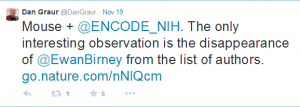
Dan Graur elected as AAAS Fellow, Birney/Gerstein Quietly Drop Out of ENCODE
Strange things are happening lately !! Dan Graur, who was called troll by renowned social media scientists BioMickWatson and Daniel MacArthur, has been elected AAAS fellow, whereas ENCODE leaders Ewan Birney and Mark Gerstein quietly left mouse ENCODE group.

On that happy note, we share with you an informative paper recently published by Elhaik and Graur. This paper explains a lot more about the compositional organization of human and mouse genomes than various ENCODE papers. Several years back, we read Bernardi’s papers and book, and he appeared quite convincing regarding his isochore theory of genome organization. Here Elhaik and Graur show that his theory is not supported by facts.
For the past four decades the compositional organization of the mammalian genome posed a formidable challenge to molecular evolutionists attempting to explain it from an evolutionary perspective. Unfortunately, most of the explanations adhered to the isochore theory, which has long been rebutted. Recently, an alternative compositional domain model was proposed depicting the human and cow genomes as composed mostly of short compositionally homogeneous and nonhomogeneous domains and a few long ones. We test the validity of this model through a rigorous sequence-based analysis of eleven completely sequenced mammalian and avian genomes. Seven attributes of compositional domains are used in the analyses: (1) the number of compositional domains, (2) compositional domain-length distribution, (3) density of compositional domains, (4) genome coverage by the different domain types, (5) degree of fit to a power-law distribution, (6) compositional domain GC content, and (7) the joint distribution of GC content and length of the different domain types. We discuss the evolution of these attributes in light of two competing phylogenetic hypotheses that differ from each other in the validity of clade Euarchontoglires. If valid, the murid genome compositional organization would be a derived state and exhibit a high similarity to that of other mammals. If invalid, the murid genome compositional organization would be closer to an ancestral state. We demonstrate that the compositional organization of the murid genome differs from those of primates and laurasiatherians, a phenomenon previously termed the murid shift, and in many ways resembles the genome of opossum. We find no support to the isochore theory. Instead, our findings depict the mammalian genome as a tapestry of mostly short homogeneous and nonhomogeneous domains and few long ones thus providing strong evidence in favor of the compositional domain model and seem to invalidate clade Euarchontoglires.
As you may have expected, good science is rarely sensational.